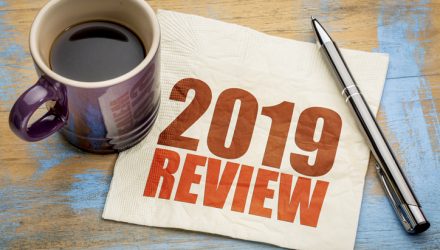The ETF Strategist Channel is comprised of more than 25 ETF strategist firms that each submit content throughout the month to educate financial advisors and investors.
Here is a look at the 10 most read ETF Strategist articles of 2019.
1. The Odds Elizabeth Warren Wins 2020 Democratic Presidential Nomination
The Big Number: 49%. That’s the current chance that Elizabeth Warren will win the 2020 Democratic Presidential Nomination, according to PredictIt. Click to read more.
2. Warren Buffett: The Investor of Today Does Not Profit from Yesterday’s Growth
“The investor of today does not profit from yesterday’s growth.” — Warren Buffett
Compared with previous quarters, the third quarter exhibited considerably more volatility with little appreciation. Most investment markets are showing signs of exhaustion due to continued uncertainty about trade wars, the negative interest rates in most developed countries, and deteriorating economic readings. Over this past quarter, we have seen companies reduce their outlook for growth and earnings, for obvious reasons. Click to read more.
3. 3 Reasons Now is the Time to Sell High-Yield
In recent weeks, Sage has become more cautious on lower-quality corporate bonds. Our caution is based on the following signals. Click to read more.
4. How to Build Your Own Long/Short Portfolio
In this week’s research note, we will explore a simple idea for how advisors and investors can “roll their own” long/short portfolio even if they do not have the ability to short individual securities. Click to read more.
5. Is Passive Investing the Next Bubble?
Almost two years ago, we wrote a piece on the decades-long trend of passive investing and its impacts on the market. The thoughts expressed in the article are still relevant today as Michael Burry, a prominent subject in Michael Lewis’ “The Big Short,” recently labeled the trend in passive investing a bubble. Click to read more.
6. A Ridiculous Question on Passive Investing
Over the past month, the financial media has once again engaged in ETF fear monger and a constant barrage of articles about the “passive bubble.” This renewed focus and blame-game was sparked by a few out of context quotes from Michael Burry in a Bloomberg article. Click to read more.
7. Market Corrections and Recovery – An Asset Allocation Perspective
We believe the greatest challenge facing investors when navigating financial markets is behavioral. The old credo of ‘buy low, sell high’ is easier said than done as evidenced by the annual Dalbar study which highlights the gap between benchmark and investor returns. Click to read more.
8. Capitalism is Alive and Well – Election Consequences
Politicians and the media do a lot of talking about the economic implications for each political platform during major elections, which mostly creates a lot of noise. In turn, much of this noise creates market volatility. However, noise and volatility become less relevant over appropriately longer time horizons for equity market investors. Click to read more.
9. Can We Have ETF Transparency With Benefits?
As we approach Thanksgiving and consider ways to express our gratitude, we are reminded by the wealth advisors we serve, and how focusing on the client experience is a form of gratitude that goes beyond gifts or special events. Providing clients with a great experience can be as simple as delivering the expected investment outcome. For many clients, that is the gift. Click to read more.
10. Our Tactical Rules are Keeping Us Invested
2019 is ending in a few weeks and the economic and stock market expansion that started in the previous decade is poised to continue into 2020. Our tactical rules support this view and are keeping us invested in equities. Until recently, all three rules of Don’t Fight the Fed, Don’t Fight the Trend, and Beware of the Crowd at Extremes were favorable for having positive equity returns over the next three to six months as the Fed was on hold, the trend was rising, and crowd sentiment was neutral. However, the enthusiasm around a potential Phase -1 trade deal between the US and China led crowd sentiment into extreme optimism territory. Click to read more.

